Miklós Barabás was born on 22 February 1810 in Kézdimárkosfalva [Mărcușa], Kovászna County (the settlement was annexed to Romania with the Treaty of Trianon). Thanks to his enthusiasm and talent for fine arts, he decided at a very young age that he wanted to be a painter. With his portrait drawings, he managed to earn so much money that he could pay the travel expenses with which he was able to travel to Vienna. There he enrolled at the Academy of Fine Arts and continued his studies there for two semesters. In order to cover his expenses, he made portraits here as well.
After his stay in Vienna, he went on a longer study trip to Italy, where he made countless watercolours of Mediterranean landscapes. After the one-and-a-half-year journey, it occurred to him that he would try his luck in Pest-Buda, as it can be read about in the 1944 edition of his autobiography.
"Then I decided to spend the winter in Pest, and if I make friends and have a job, I will stay even longer."
Portrait of Miklós Barabás (Source: ELTE University Library/Hungaricana)
After his arrival in Pest, the classicist was accommodated in the Nákó House (it stood on the site of the Gresham Palace on today's Széchenyi Square), where he lived in a sublet with a Saxon scientist named Müller. The building also played an important role in the history of Hungarian science, as the first floor was the home of the Hungarian Academy of Sciences before its magnificent headquarters was built. Although Barabás lived in one of the most magnificent buildings in Pest, at that time he did not plan to settle permanently in the city.
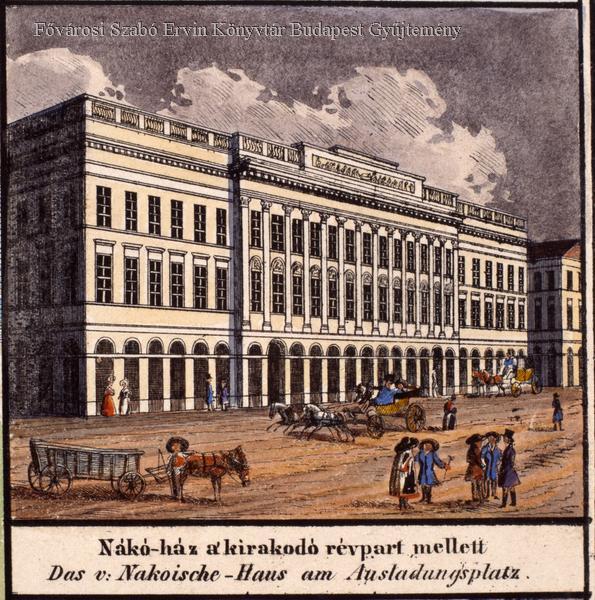
Carl Vasquez's drawing of the Nákó House, which once stood on Széchenyi István Square (Source: FSZEK Budapest Collection)
As a painter, he first presented himself to the public in the capital in 1835 at the National Casino, where a copy of one of Veronese's paintings, The Rape of Europa, was exhibited. His talent created a sensation, but his career only really started to rise when he met one of the outstanding individuals of the Reform era, József Bajza. It was then that he was commissioned to create a portrait of Mihály Vörösmarty, which became the ideal type of Biedermeier portrait painting, the leading style of the Reform era. After that, he also created a portrait of Széchenyi for the county of Bihar, thanks to which he instantly became known among the capital's aristocracy. Thanks to his successes, he was able to call Pest his home, albeit with minor interruptions.
"In 1836, after the New Year, I had a steady job and my name became so well known that I decided to settle here"
- wrote the famous painter in his autobiography.
József Square (now József Nádor Square) in Carl Vasquez's drawing, where Miklós Barabás moved (Source: National Széchényi Library Map Library)
In 1836, Barabás received successive orders to produce academic and county portraits, and he was elected a corresponding member of the Hungarian Academy of Sciences. That year, his place of residence also changed: he left the Nákó House behind.
"Miklós Barabás of Márkosfalva needed a more spacious studio, so he changed his accommodation from the Nákó House to the Almásy House at 160 Jó'sefpiacz, on the second floor"
- reported the literary journal Rajzolatok a társas élet és divatvilágból on 14 May 1836.
He was also in Pest during the great flood of 1838. In his autobiography, he wrote in detail about how the ice floes blocked the Danube and about the terror the next day due to the rising water level. He could not stay in his apartment because it became life-threatening, so he fled to Buda. During his short stay here, he also had breakfast at the Szarvas café, then decided to travel to Kolozsvár [Cluj-Napoca] to avoid the flood.
The painter and his family on the steps of the Barabás Villa at 44 Városmajor Street (Source: Fotóművészet, May-June 2006)
The Barabás Villa nowadays (Photo: Balázs Both/pestbuda.hu)
When he returned to Pest-Buda in 1839, he bought the vineyard plot at 44 Városmajor Street for 2,000 forints, on which there was a small press house with a room and a kitchen. However, his financial situation did not yet allow him to build his own building, so that only happened in the summer of 1840.
The building of the classicist villa was designed by Barabás and was originally intended as a summer flat so that he could escape from the noise of the city. He and his wife Zsuzsanna Bois de Chesne, whom they married in June 1841, lived in this house for many years. He also made a watercolour of the building, which served as important documentation during the recent renovation. However, he still kept his studio in the Wieser House on Feldunasor (it was located at today's 8 Széchenyi István Square) on the Pest side.
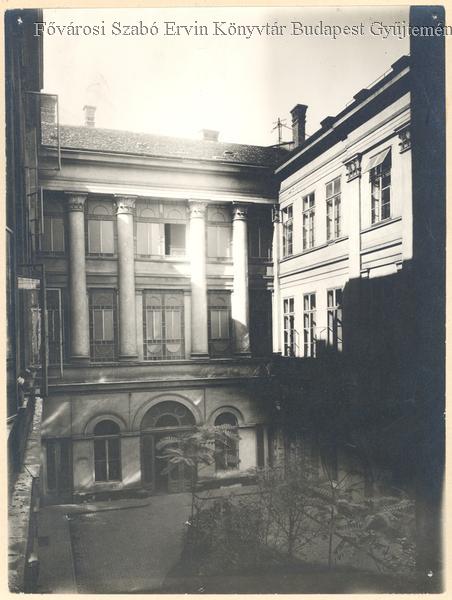
The Wieser House, where Miklós Barabás once had his studio (Source: FSZEK Budapest Collection)
He painted his best-known work, the Galambposta [Pigeon Post], in 1840, which he presented to the public with great success at the first exhibition of the Pest Art Society on the first floor of the old Redout overlooking Nagyhíd Street. Barabás not only exhibited his works but in 1841 and 1842 he was also commissioned to organise the exhibitions. The building was destroyed during the War of Independence in 1848-1849.
Miklós Barabás's watercolour A hajóhíd az épülő Lánchíd pilléreivel [The pontoon bridge with the pillars of the Chain Bridge under construction] (Source: Széchenyi István. Edited by Ervin Fenyő.
Helikon Publishing House, Budapest, 1991, picture No. 81)
Barabás was highly respected. The contemporary press regularly reported on his works in progress. He painted many famous people. In addition to his portraits of Mihály Vörösmarty and Count István Széchenyi, he painted Ferenc Deák, Archbishop János Pyrker of Eger, Lajos Batthyány, Ferenc Liszt, János Arany, Franz Joseph I and Palatine Joseph, whose portrait also features the floor plan of Pest and the National Museum.
"His biography is history written with a brush. And it also includes many watercolours depicting Budapest, which has developed into the capital. Countless panoramas from City Park to Zugliget reflect the image of the city at that time"
- wrote the 8th issue of the Budapest magazine in 1976.

One of Barabás's best-known paintings is the Lánchíd alapkőletétele [Laying the Foundation Stone of the Chain Bridge], the picture captured an important moment in the history of the capital
It is not known why, but in 1847 Barabás finally decided to build a studio for his villa in Városmajor. From then on, he received his important guests and took his portraits here. The revolution of 1848 also hit the Barabás Family here, which he commemorated in his autobiography as follows:
"When Hentzi started bombing Pest, we were sitting at dinner. [...] the bombs fly over our house, especially when one exploded above our house and its heavy pieces made a terrible clatter on the roof tiles [...] The infernal noise caused by the bombs falling in the nearby streets was terrible."
Miklós Barabás' photography studio on the corner of Úri and Korona Street (Source: Fotóművészet, May–June 2006)
In 1861, he was elected co-chairman of the newly established Society of Fine Arts, and that year he was also voted for as a representative in the Pest city council. This year he also suffered a painful loss: his beloved wife passed away. His portrait orders also declined, so he decided to open a photo studio on the corner of Úri Street (now Petőfi Sándor Street) and Korona Street (now Régi Posta Street). The business proved to be neither successful nor long-lived: in 1864, he parted ways with the photo studio.
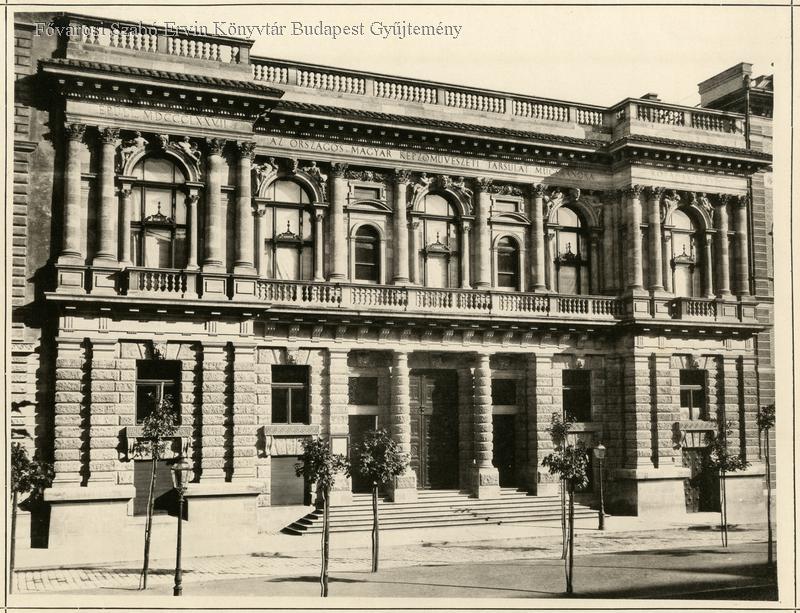
An exhibition of Barabás's works was held a year later in the building of the Kunsthalle, handed over in 1877 (Source: FSZEK Budapest Collection)
He immortalised the streets of the capital countless times. He presented his best-known painting of Pest, A Lánchíd alapkőletétele [Laying the Foundation Stone of the Chain Bridge], in 1864 at the exhibition of the Society of Fine Arts. It became one of the defining works not only of Barabás's oeuvre but also of the era. In 1857, the patron baron, Simon Sina, ordered the picture from the famous artist, who presented the work to the National Museum after the presentation in the gallery.
The subject has been elaborated several times: He made a watercolour of the event for W. T. Clark in 1843 and for Queen Elizabeth's album in 1854, and then in 1859 he also painted a small painting of the ceremony. He also made several watercolours about the construction of the bridge, which document the phases of the construction well.
He celebrated the 50th anniversary of his creative era in 1878, in honour of which an exhibition of his works was organised in the Kunsthalle building on Andrássy Avenue. The public could see 398 of his works at the exhibition.
"But there is hardly anyone who would find so many acquaintances and so many good friends in this exhibition as the writer and artist. There is a pleasant surprise in front of us on every wall, art annexes from the old Auroras, Életképek and other companies, Heckenaszt's albums and so many other well-known figures from our childhood come to life in front of us, and from the beginning of the century to the present year, we find the portraits of every famous writer and artist there."
- the Hon wrote about the exhibition on 15 March 1878.
The tombstone of Miklós Barabás in the Fiumei Road Cemetery. The statue of the artist holding a paint palette and brush was created by Ede Telcs (Source: Vasárnapi Ujság, 11 June 1905)
They did not forget him at the millennium exhibition either: many of the old artist's works were exhibited. Two years later, ten days before his 88th birthday, on 12 February 1898, he died in Budapest. On 13 February, the Pesti Hírlap reported on the death of the great artist with these words:
"The nestor and one of the first pioneers of Hungarian painting died this morning. Barabás was one of the leading figures of Hungarian fine arts for more than half a century. His name was known and respected, and there was hardly a more famous figure in the country who was not immortalised by his brush."
His body was laid to rest in the Fiumei Road Cemetery two days after his death, on 14 February 1898. His tombstone was created by the sculptor Ede Telcs and inaugurated on 6 June 1905.
Cover photo: A Lánchíd alapkőletétele [Laying the Foundation Stone of the Chain Bridge]

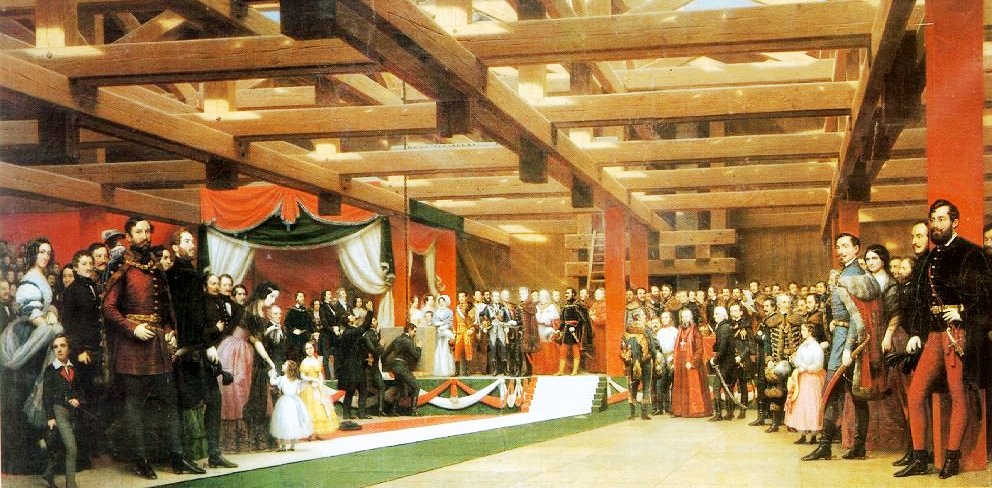
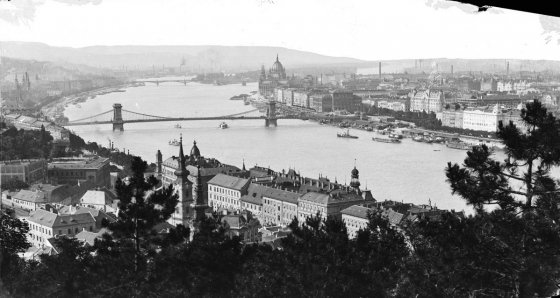




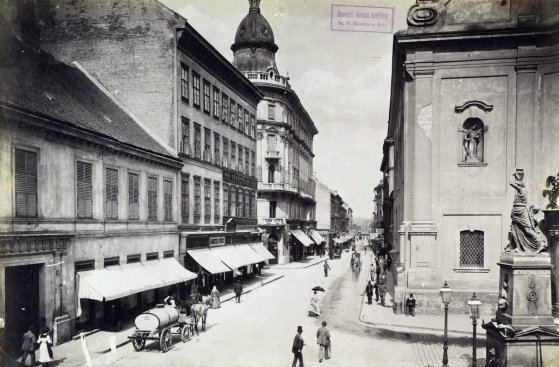



























Hozzászólások
Log in or register to comment!
Login Registration